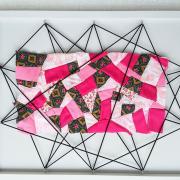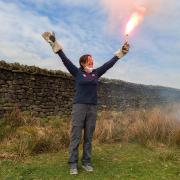'It was there that I found myself and what I might do. The life and place were what I yearned for – the freedom, the austerity, the savagery, the wilderness. I loved the cold and the northerly storms when no covering would protect you. I loved the strange race of people who lived there, whose stern almost forbidding exterior formed such contrasts to the warmth and richness of their nature.'
There’s high drama in the reaction of the great artist Dame Laura Knight to the North Yorkshire coastal village that became her spiritual home for around 15 years from 1894. Staithes, at the northern end of the county, is to this day one of the most popular destinations for visitors to this area (and these days, a little more forgiving in temperament than it was 130 years ago!).
The Staithes Group of Artists – a somewhat looser collective than its more famous rival down in Newlyn – comprised Dame Laura and her husband Harold, Hannah Hoyland, Mark Senior, Ernest Dade, Frank Mason and a dozen or so other talented painters.

They weren’t exclusively marine artists, but they were undoubtedly brought together by their love of the sea, this coast, and the great outdoors – generally, their preferred method was to get out there and paint directly from nature, a technique known as ‘en plein air’, which gave their work a freshness and immediacy.
The largest collection of artwork by the Staithes Group anywhere is in the beautiful Pannett Park Art Gallery in Whitby – snuggled against the town’s museum, it’s also home to a wide range of other maritime art.
Head 20 miles down the coast and you’ll find the stately Scarborough Art Gallery, home to another fine collection of coastal art including works by Mason, Dade, Ernest Roe and, of course, John Atkinson Grimshaw.

Best known as the man who redefined moonlight, the Victorian artist was an avid painter of maritime scenes, with subjects ranging from the peaceful lights in Scarborough harbour to the dramatic Burning Off, a depiction of the practice of burning barrels of oil on the pier to guide home fishing boats in stormy weather.
Artists are still to this day inspired by the beauty of our coast – when you’re making your artistic tour, don’t forget to visit one of the many independent galleries displaying and selling contemporary work. And look out, too, for some great visual arts festivals: two of five brand new events under The Scarborough Fair umbrella:
Scarborough Streets (May) is a hybrid street arts festival including visual arts and Scarborough Arts (June to August) is an affordable art trail in venues such as pop-up shops and studios. Staithes, of course, has its own unique Festival of Arts and Heritage, this year taking place September 14-15, which sees the entire village transformed into one huge gallery with homes and shops hosting pop-ups, fascinating workshops and talks, and live music.
For more information on what else is on across the Yorkshire Coast and the North York Moors this month, please visit
discoveryorkshirecoast.com
Want to explore the North Yorkshire coast’s artistic heritage further?
Scarborough’s Paint the Town trail, an initiative from the local Civic Society, leads you around high-quality reproductions of locally themed artworks in the collections of Scarborough Museums and Galleries placed at the sites which inspired them. Find it on the free Love Exploring app, along with an audio description of the history of art in Scarborough. A similar Pannett Art Gallery trail can be found in Whitby.
We asked two leading figures in the arts community on the North Yorkshire coast to choose a painting from their collections that means something to them.

Helen Berry, Curator at Whitby’s Pannett Art Gallery
Low Tide On The Beck, by Glasgow-born artist Harrington Mann.
You can see it in Pannett Art Gallery. Helen says: ‘I love the intensity of colour in this painting. Mann was a member of the Glasgow Boys, radical young painters who rejected academic painting, and instead painted contemporary rural subjects. Like the Staithes Group of Artists, they often worked out of doors (en plein air).
‘Many of Mann’s early paintings were of fishing communities along the Yorkshire coast and for over 10 years he painted in the Staithes area. Although he wasn’t a core member of the Staithes Group, he painted alongside its members, influencing, and being influenced by, them.

‘Painting in all weathers, using a portable easel, and often the recently invented tube paint, artists painting en plein air used quick, spontaneous brush strokes and a simplified palette to complete whole paintings.
‘In this painting Mann captures the essence of a summer’s day: with bleached land, deep shadows, and an almost luminous river and sea, you can practically feel the intensity of the sun. Although it’s small, and almost impressionistic in style, look closely and you will notice Mann has captured a great deal of detail, including the mooring ropes anchoring the fishing boats to the shore, and fishermen tending their boats.
‘This painting brightens up winter days with the promise of better weather coming soon.’

Andrew Clay, chief executive at Scarborough Museums and Galleries
T Ramsay’s painting of the town’s South Bay beach, painted around 1770.
It is currently on display at Scarborough Art Gallery on The Crescent. In a remarkable instance of artistic circularity,
Andrew is the great-great grandson of Mark Senior, one of the founder members of the Staithes Group.
Andrew says: ‘I love this painting because it shows fashionable society visiting Scarborough in that early period of tourism. We can see the bathing machines, the people in their fashionable clothes on the beach and a carriage on the right-hand side.

‘Above them we can see the local topography, including some buildings that still exist, some near where the Grand Hotel now stands. ‘This painting gives a glimpse of Scarborough at that time and we can cross reference it to the other paintings in our collection to see how the town has changed over the time.
‘It’s evidence that Scarborough is one of the oldest – maybe even the first! – tourist destination in the world and certainly in the UK, where people would come to take the waters and engage in activities such as sea bathing. Initially, this was the preserve of the rich, but the arrival of the railways in the 1840s made Scarborough and other, similar resorts across Britain more accessible to all sections of society.’



























